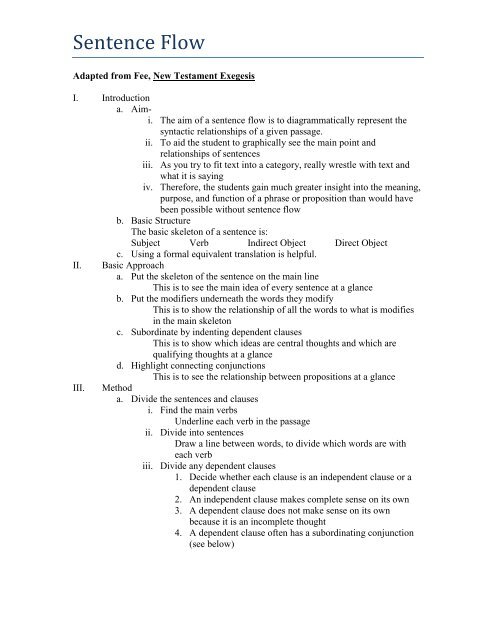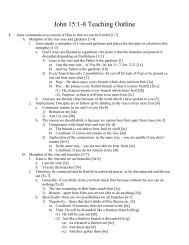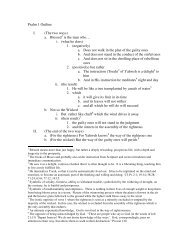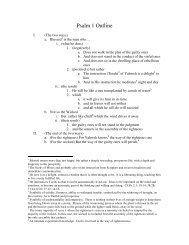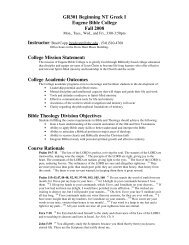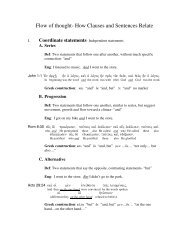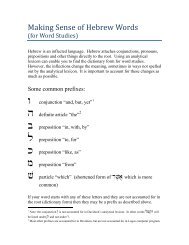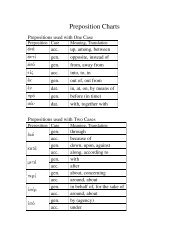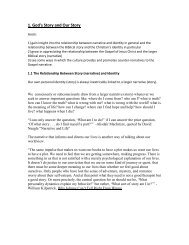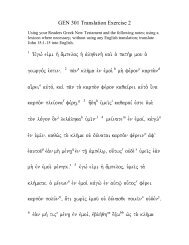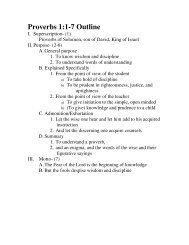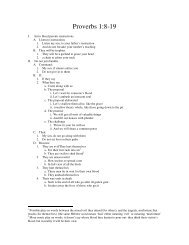You also want an ePaper? Increase the reach of your titles
YUMPU automatically turns print PDFs into web optimized ePapers that Google loves.
<strong>Sentence</strong> <strong>Flow</strong><br />
Adapted from Fee, New Testament Exegesis<br />
I. Introduction<br />
a. Aimi.<br />
The aim of a sentence flow is to diagrammatically represent the<br />
syntactic relationships of a given passage.<br />
ii. To aid the student to graphically see the main point and<br />
relationships of sentences<br />
iii. As you try to fit text into a category, really wrestle with text and<br />
what it is saying<br />
iv. Therefore, the students gain much greater insight into the meaning,<br />
purpose, and function of a phrase or proposition than would have<br />
been possible without sentence flow<br />
b. Basic Structure<br />
The basic skeleton of a sentence is:<br />
Subject Verb Indirect Object Direct Object<br />
c. Using a formal equivalent translation is helpful.<br />
II. Basic Approach<br />
a. Put the skeleton of the sentence on the main line<br />
This is to see the main idea of every sentence at a glance<br />
b. Put the modifiers underneath the words they modify<br />
This is to show the relationship of all the words to what is modifies<br />
in the main skeleton<br />
c. Subordinate by indenting dependent clauses<br />
This is to show which ideas are central thoughts and which are<br />
qualifying thoughts at a glance<br />
d. Highlight connecting conjunctions<br />
This is to see the relationship between propositions at a glance<br />
III. <strong>Method</strong><br />
a. Divide the sentences and clauses<br />
i. Find the main verbs<br />
Underline each verb in the passage<br />
ii. Divide into sentences<br />
Draw a line between words, to divide which words are with<br />
each verb<br />
iii. Divide any dependent clauses<br />
1. Decide whether each clause is an independent clause or a<br />
dependent clause<br />
2. An independent clause makes <strong>com</strong>plete sense on its own<br />
3. A dependent clause does not make sense on its own<br />
because it is an in<strong>com</strong>plete thought<br />
4. A dependent clause often has a subordinating conjunction<br />
(see below)
. Display the main sentences<br />
i. List the main verbs<br />
Write the verbs down the page with plenty of space between<br />
ii. For each verb, List the subject and any objects<br />
Write the subject before the verb and any objects after<br />
Subject Verb (Indirect Object) (Direct Object)<br />
iii. Display the modifiers in the proper position<br />
Determine which part of the skeleton it modifies<br />
Display them under what they modify (slightly indented)<br />
Subject Verb (Indirect Object) (Direct Object)<br />
modifiers modifiers modifiers modifiers<br />
c. Display dependent clauses by subordination<br />
i. Participle clauses (“-ing” clauses)<br />
ii. Infinitive clauses (“to –“ clauses)<br />
iii. Adverbial clauses (Reason, Purpose, etc.)<br />
iv. Relative clauses (“who…”, “which…” clauses)<br />
Relative clauses can be recognized by the following relative<br />
conjunctions:<br />
That, which, whichever, who, whoever, whom, whose, whosever,<br />
whomever<br />
v. Subordinate clauses can be recognized by the following<br />
subordinating conjunctions:<br />
after, although, as, because, before, even if, even though, if, in<br />
order, that, once, provided that, rather than, since, so that, than,<br />
that, though, unless, until, when, whenever, where, whereas,<br />
wherever, whether, while, why<br />
Subject Verb (Indirect Object) (Direct Object)<br />
subordinating conjunction<br />
subordinate clause (subj. verb. Object)<br />
d. Isolate and Highlight coordinating conjunctions by placing them to the left<br />
Conj.<br />
Subject Verb Object<br />
Subject Verb Object<br />
e. Use color to highlight repeated words and continuing or contrasting<br />
themes<br />
f. Use the structure of the diagram to show lists and parallel thoughts<br />
Subject Verb Object<br />
prep. phrase<br />
prep. phrase<br />
prep. phrase
IV. Example<br />
1 Corinthians 2:1-8<br />
And when I came<br />
to you, brethren,<br />
I did not <strong>com</strong>e<br />
with superiority of speech<br />
or<br />
of wisdom,<br />
proclaiming to you the testimony of God.<br />
For<br />
I determined to know nothing<br />
among you<br />
except<br />
Jesus Christ,<br />
and Him crucified.<br />
I was<br />
with you<br />
in weakness<br />
and in fear<br />
and in much trembling,<br />
and my message<br />
and my preaching<br />
but<br />
your faith<br />
but<br />
were not<br />
in persuasive words of wisdom,<br />
in demonstration of the Spirit and of power,<br />
so that<br />
would not rest<br />
on the wisdom of men,<br />
on the power of God.<br />
Yet we do speak wisdom<br />
among those who are mature;<br />
a wisdom,<br />
however,<br />
not<br />
nor<br />
but we speak God's wisdom<br />
in a mystery,<br />
the hidden wisdom<br />
which<br />
God<br />
of this age<br />
of the rulers of this age,<br />
who are passing away;<br />
predestined<br />
before the ages<br />
to our glory;


